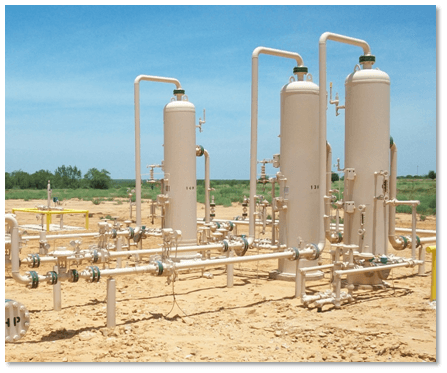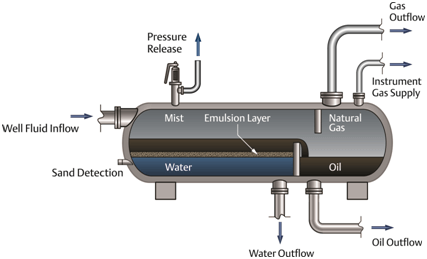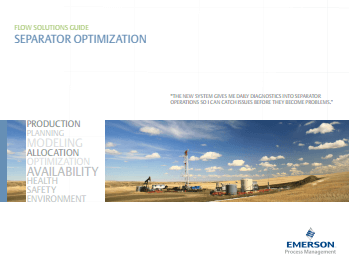Author: Lee Rumbles
The separation process in upstream holds the key to maximizing oil and gas production. We’ve explored the importance of flow measurement for separators, now let’s examine ways in which these flow points can be optimized so they help achieve your operational goals.
Why optimize? There are few process units in oil and gas production that offer as much potential insight into the efficiency of your operation as a separator. An optimized separator has the potential to inform how your well is performing, identify changes needed to ensure maximum production, and deliver insight into the well’s stage of production.
Reduce uncertainty. Without accurate flow measurement and diagnostic capabilities on your separator, phase carry-over or carry-under can easily occur and you may never be aware it’s happening.
For example, in gas carry-under the gas is entrained in oil and exits the oil outflow point where it heads downstream, often to a storage tank. As a result, the gas will be vented and eventually burned off with a flare system. This gas is now vented or burned away instead of measured at the gas outlet and sold.
Likewise, in liquid carry-over, valuable natural gas liquids (NGLs) with high BTU content are drawn off the liquids and exit with the gas. This can occur because the level in the separator is too high or the pressure within is too low but, regardless, you’re giving away valuable product at the gas outflow point.
Flow measurement technologies with diagnostic capabilities give you insight into what’s really going on. These are only a couple of examples of issues that can occur – and could have easily been overcome – that increase uncertainty in your operation and compromise your production management decisions. Several options exist to help you optimize the Water Outflow, Oil Outflow, and Gas Outflow points including Micro Motion Coriolis meters that use flow, density, and drive gain measurements to alert you of issues or the Rosemount Ultrasonic meter that uses flow profile and speed of sound diagnostics.
Read about how this kind of separator uncertainty was managed in Eagle Ford.
In addition, at the Water Outflow point, you can detect whether the separator has been drained and you are blowing gas through the water leg because of a stuck-open dump valve using the SMART fluid diagnostic in the Rosemount Vortex meter.
Spend less time in the field. Time spent in the field inspecting problems, fixing devices, or checking data is not only inefficient but can increase safety risk and cost. Instead, you should focus on flow measurement devices that require minimal maintenance, offer remote diagnostics capabilities, and can automate processes to deliver information to you.
To truly optimize your separator make sure you are exploring the advantages of the best flow measurement technologies. Unlike years ago when the choice of measurement devices was limited, there’s never been a better time to adopt devices that can add real value to your operation. In flowmeter technology selection, consider Coriolis or Ultrasonic meters that offer:
- No moving or wearing parts that can wear or break down
- Easy-to-maintain instruments that require little day-to-day interaction
- Highly accurate, robust, field-proven, and reliable flowmeters
Several flow measurement technologies also offer diagnostics remotely. For example, in-situ meter verification is an easy-to-use diagnostic that takes just a few minutes but can assess the flow device to assure device performance. Emerson offers this on its Micro Motion Coriolis meters and Rosemount Magnetic flowmeters.
Remote separator diagnostics are also available to assess separator operations, monitor issues, and determine solutions before sending anyone to the field. Diagnostic information can be integrated into the Remote Terminal Units (RTUs), so operators can monitor events and use the information to respond to upset conditions more quickly.
Periodically, wells need to be rotated through the test separator in order to evaluate production performance of individual wells and manage reservoirs properly. Typically a manual process, it is now possible to automate testing over a set timeframe. The Well Test Manager, within the RTU, automates well testing with an easy-to-use process that can be programmed to your schedule and delivers an alert if testing results are not as expected. Optimizing well testing saves manpower, improves safety, and acts as a quality assurance measure.
Reach first production faster. Consider a range of factors in choosing your flow measurement devices, including the experience and support you can expect to receive before, during, and after installation. Selection factors should include:
- Field-proven, reliable technologies designed for the oilfield
- Technology selection that considers application, location, and operating goals
- Application expertise that is backed by other successful installations
- Field services that include application assessment, installation, start up, commissioning, troubleshooting, and training
- Single-sourced technologies and services
To make the most of your separator, check out Emerson’s separator optimization guide.
You can connect and interact with other flow measurement and oil & gas professionals in the Flow Measurement and Oil & Gas tracks of the Emerson Exchange 365 community.




